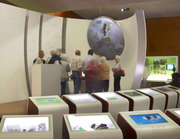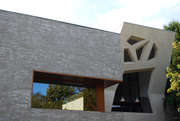The museum was opened on the 13th June 2010, 25 years after the signing of the Schengen Treaty.
The European Museum Schengen is located in the tripoint of Luxembourg-Germany-France on the Moselle. It was in Schengen that on the 14th June 1985 representatives of the five EU member states Germany, France, Belgium, Netherlands and Luxembourg met on the passenger ship Princesse Marie-Astrid to sign an agreement eliminating border controls, the so called first Schengen Agreement (another agreement was signed in 1990).
The permanent exhibition on the history and significance of the Schengen Agreements, on 200 square meters of exhibition space, shows visitors that the elimination of the control of persons at the internal borders put into practice one ot the four foundational European freedoms set down in the 1957 Treaty of Rome.
Over the past 30 years the concept of the "Schengen Area" has become a positive symbol for freedom of travel and the elimination of borders in Europe. The trilingual permanent exhibition of the European Museum Schengen (F, D, EN) conveys a basic knowledge of several sets of topics.
The most famous village in the world
The name "Schengen" is "on everyone´s tongue" in the truest sense of the phrase. In a video-installation 28 people from all over the world enter the picture one after another in life-size and say "Schengen" in the particular inflection of their native tongue.
What is Schengen really?
The visitor learn the dates of turning points for the village and its surrounding region in the tripoint, from the Neolithic up to today.
The birth of the Schengen Area and its expansion
The signing of the Agreement in 1985, exhibited here, is documented with historic photos, videos and sound footage as well as statements by those involved at the time.
This is supplemented by explanations of the content of the central Agreements (Schengen 1985/1990 and Amsterdam 1997/1999).
A glossary, available in the form of a software application called "Schengen ABC", familiarizes visitors with the central concepts of the contractual agreements.
An interactive history of Europe´s borders

The animation seeks to explain visitors how the borders within the continent of Europe have changed since 1815 and with them the associated political and economic relations of power. It also makes clear the difference between the "Schengen Area" and the "EU".
What is a border?
An animation combining photos and text visualizes the range of everything that could fall under the category of "border". From garden fences to historic stone walls all the way to spring-guns.
The collective "We"-feeling
The free movement of people within the Schengen Area and the new external borders have changed the lives of Europeans. The exhibition contributes to the sense and purpose of European integration with an animated film-installation.
External borders, entry and border controls
On the central topic of the Schengen Area´s external borders the museum informs its visitors about the European Agency for the Management of Operational Cooperation at the External borders of the Member States of the European Union (Frontex) and on modern border techiques.
On the complex issues if the entry of citizens of third-party states, the European Museum Schengen documents the procedure of applying for a visa, and at the same time offers information about the living conditions in several third-world states so that the visitor comes to understand the attraction Europe has for people in many parts of the world.

Control mechanisms such as SIS (Schengen-Information-System) exist so that the elimination of internal border controls doesn´t lead to a threat to security or missing tax revenue. Exhibition pieces on the topic of smuggling and statements by customs officers and police on their work complete the picture.
Schengen for Kids
Participatory elements for children round out the permanent exhibition and offer content related to the Schengen Area. There are a variety of options that children can make use of during their visit together with their parents.

